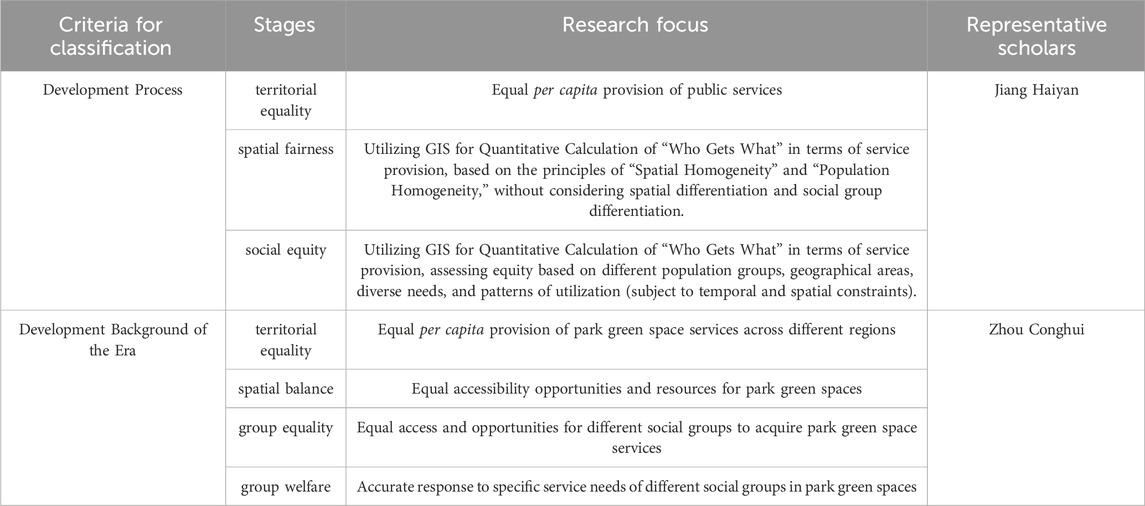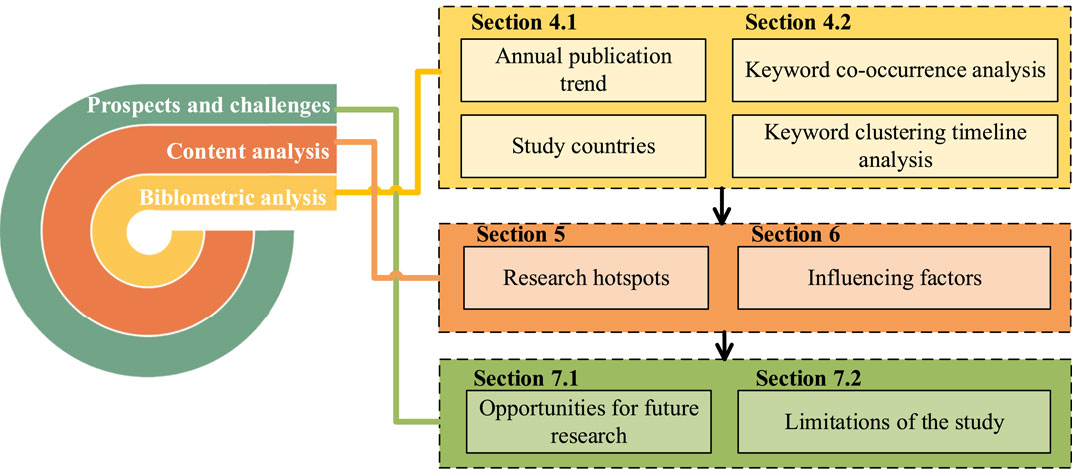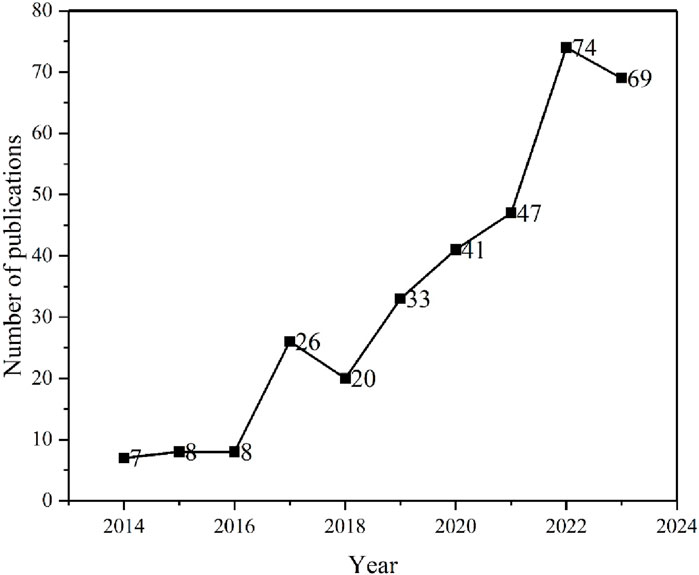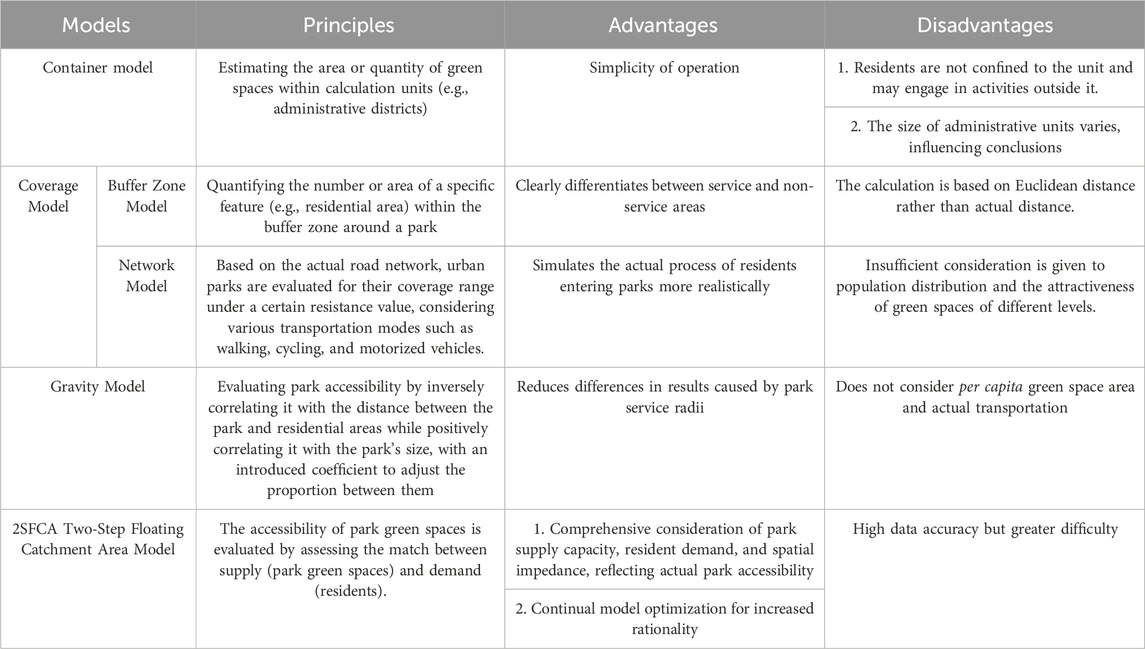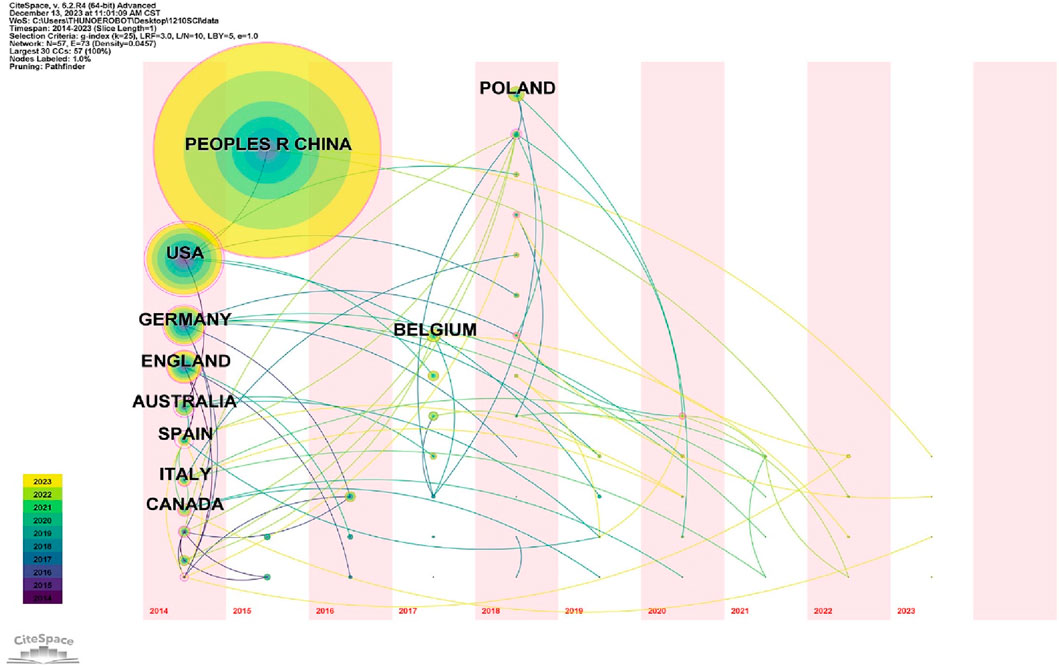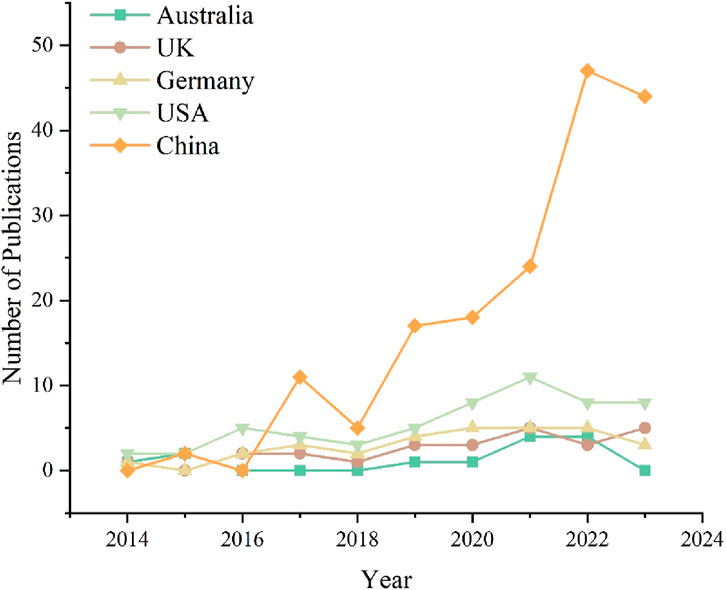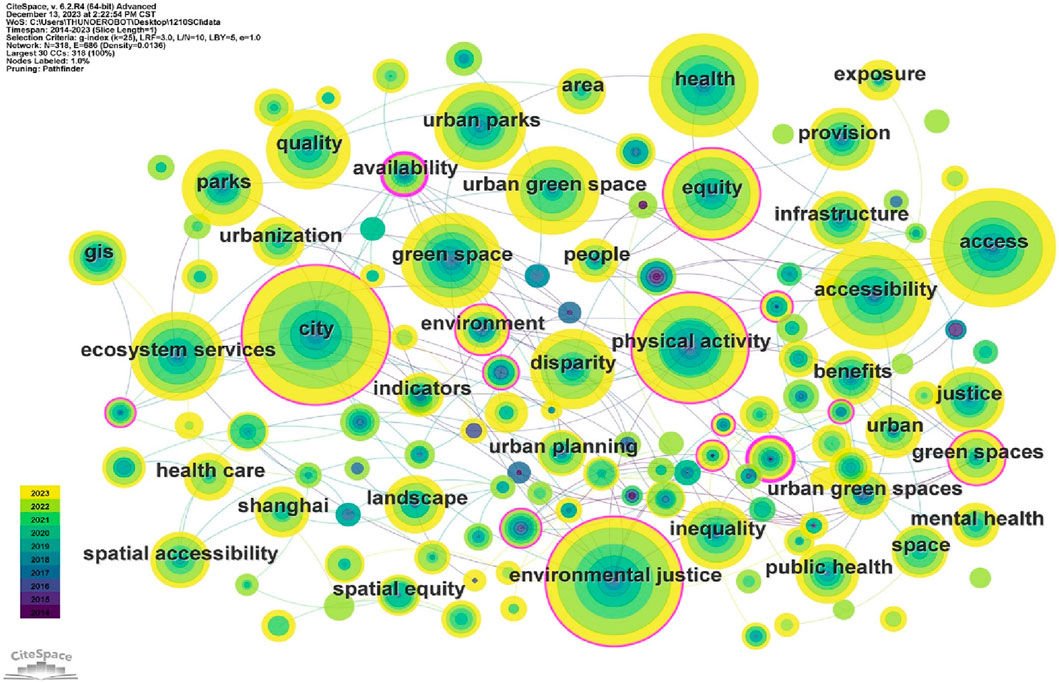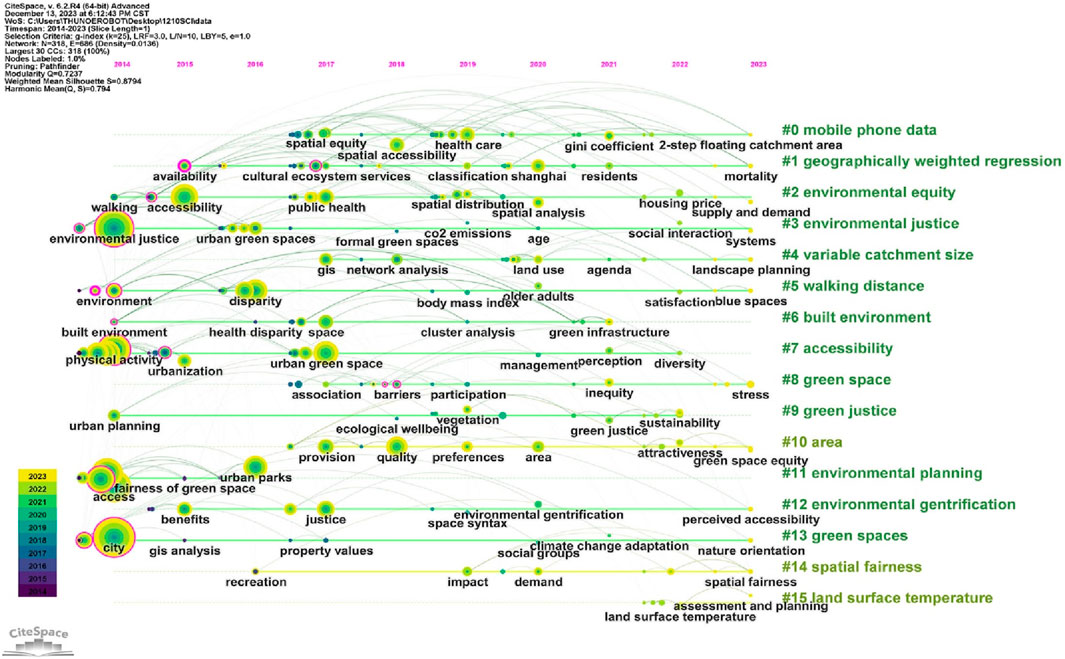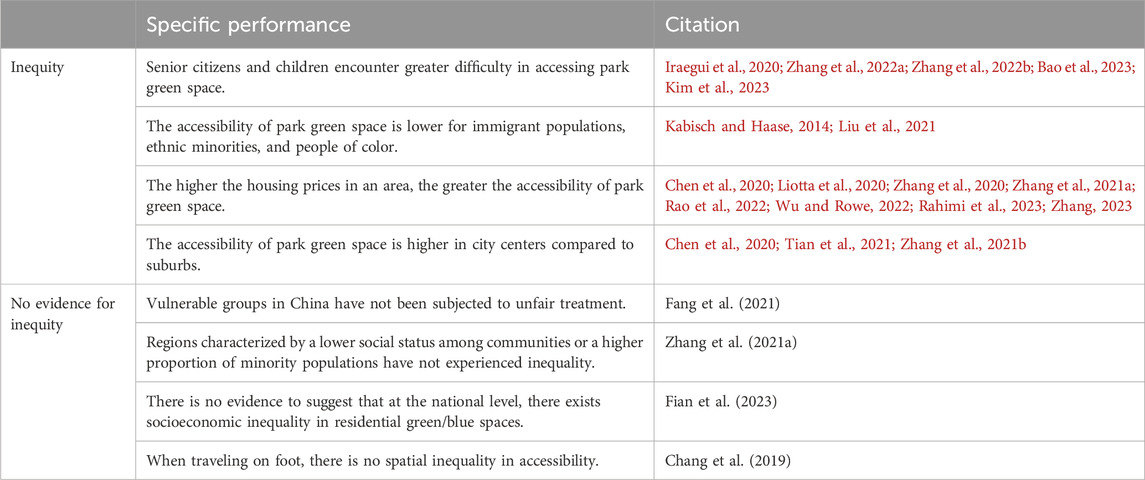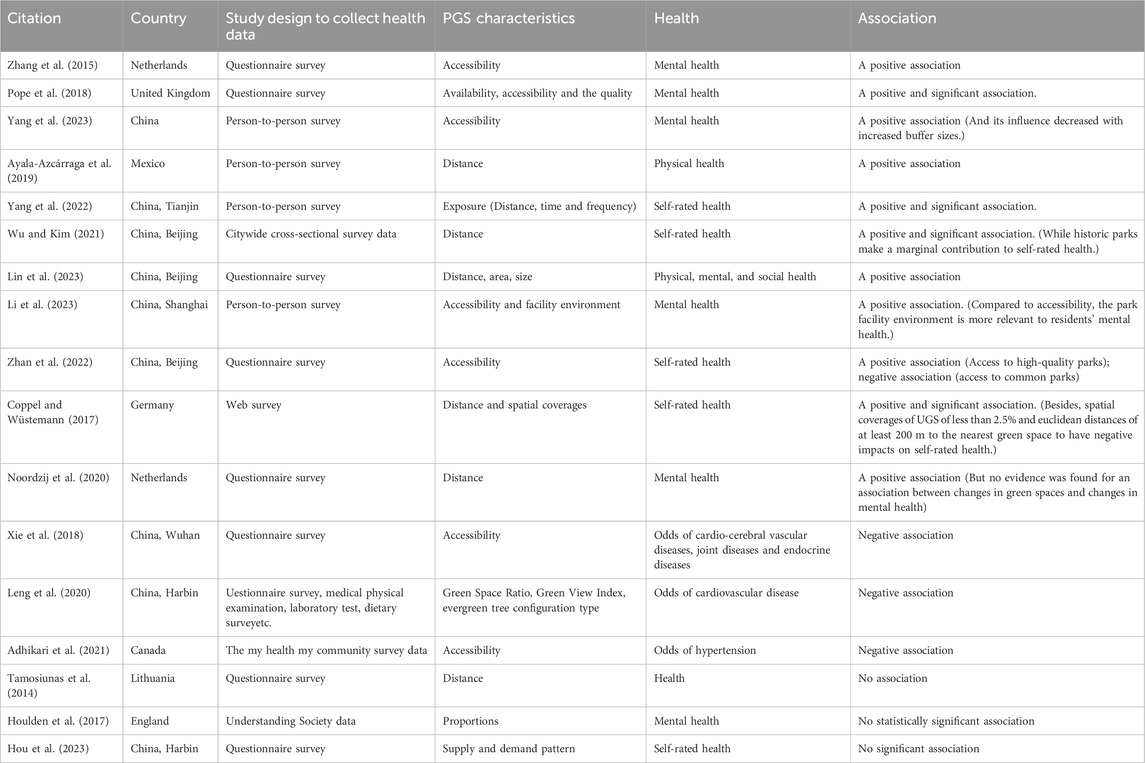- 1Ecological Technique and Engineering College, Shanghai Institute of Technology, Shanghai, China
- 2Pan Tianshou College of Architecture, Art and Design, Ningbo University, Ningbo, China
With the global increase in population and the accelerated process of urbanization, the equitable access to park green spaces by diverse communities has become a growing concern. In order to provide an overview of the developmental trends, research focal points, and influencing factors in the study of equity in park green spaces, this paper employs bibliometric analysis and the visualization software CiteSpace to systematically analyze relevant literature in the Web of Science core database from 2014 to December 2023. The findings reveal an increasing emphasis on the research of equity in park green spaces, delineated into two distinct phases: a period of gradual exploration (2014–2018) followed by rapid development (2018 to present). Key nations contributing to research in this domain include China, the United States, and Germany. Currently, the research focus in this field primarily centers on the analysis of park green space equity based on primary social fairness, analysis of park green space equity based on vulnerable groups, and the relationship between park green spaces and health. The influencing factors of park green space equity mainly involve regional economic factors and government planning, as well as residents’ economic capabilities and racial discrimination. Future research directions could include studying park green space equity among different demographic groups, emerging assessment methods and data, park green space equity based on perceived accessibility, and the relationship between park green space equity and surface temperature.
1 Introduction
In accordance with the latest United Nations report, over 56% of the global population currently resides in urban areas, with an anticipated projection that urban populations will constitute 70% of the world’s total population by 2050 (UN-Habitat, 2022). Throughout the process of urbanization, extensive land development has inflicted severe damage upon the ecological environment, resulting in a reduction of biodiversity and a decline in air quality. Research indicates that urban parks and green spaces have yield diverse benefits by providing a secure habitat and favorable living conditions for various species, preserving the ecological balance of urban areas, improving air quality (Kroeger et al., 2014), and mitigating the urban heat island effect (Donovan and Butry, 2009).
As integral components of urban ecosystems and pivotal platforms for recreational activities, park green spaces play a crucial role in ensuring the sustainable development of cities. However, the widening gap between socioeconomic classes has led to conspicuous inequalities in the distribution and utilization of these spaces among different societal groups. The equity of park green spaces has gradually become a significant indicator for measuring social sustainability, attracting widespread attention from academia, government bodies, and even the planning sector. For instance, the European Environment Agency recommends that urban residents should have access to green spaces within a 15-min walk, equivalent to approximately 900–1,000 m (Stanners and Bourdeau, 1995). Some scholars propose the 3–30-300 rule, suggesting that everyone should be able to see at least 3 mature trees from their home; there should be a tree canopy cover of at least 30% nearby; and individuals should reside within a 300-m radius of high-quality public green spaces (covering at least 0.5 ha) (Browning et al., 2024). In the United Kingdom, urban residents are suggested to have 2 ha of urban green supply within a 300-m radius of their residences (Handley et al., 2003). Nevertheless, some of these recommendations for park green spaces provision may be impractical, and assessing equity standards may entail diverse needs within different cultural backgrounds and regional environments, rendering the evaluation of equity in park green spaces complex and multifaceted.
Scientific knowledge mapping is a visual representation of the development process and structural relationships within a specific field of knowledge. CiteSpace is an information visualization software designed to analyze scientific knowledge maps of literature related to a particular research topic. It generates visual maps by selecting specific information such as authors, institutions, keywords, or co-citations, allowing for the analysis of the current status, hotspots, and forefront directions of research in the field (Chen, 2017). Although scholars have conducted analyses of citation and co-occurrence relationships among relevant literature using CiteSpace, these analyses have been limited to a simple interpretation and factual presentation of scientific knowledge graphs and bibliometric results, with constraints on the detailed content analysis of specific articles. With the increasing emphasis on research regarding park green spaces and their equity, a growing body of research outcomes is emerging. An analysis of the current status, hotspots, influencing factors, and dynamic frontiers of equity in park green spaces is beneficial for understanding the theoretical underpinnings and trends of this field, contributing significantly to the advancement of global sustainable development.
Therefore, this paper utilizes bibliometric analysis and content analysis, employing CiteSpace for literature measurement and visualization, to quantitatively analyze the current state of equity in park green spaces research. It seeks to summarize and categorize research hotspots, influencing factors, and frontiers. The objectives of this study include: 1) providing a comprehensive review and extension of the concept and content of equity in park green spaces; 2) quantifying and elucidating the publication timeline, contributing countries, research hotspots, and themes in equity of park green space research; 3) delving into the influencing factors of equity in park green space; 4) highlighting key research areas within the three aforementioned directions; 5) acknowledging the limitations, future prospects, and challenges of this study. The results aim to offer valuable insights for the future global planning and management of park green spaces, providing theoretical guidance for advancing equity in park green space research.
2 Conceptual
2.1 The concept of equity in park green spaces
2.1.1 Park green spaces
This paper, following the definition of Park Green Spaces outlined in China’s ‘Classification Standard for Urban Green Spaces’ (CJJT85-2017) (Standard for Classification of Urban Green Space, 2017), defines Park green spaces as areas open to the public primarily for recreational purposes, while also serving ecological, landscape, cultural, educational, and emergency evacuation functions, with certain recreational and service facilities.
2.1.2 Equity in park green spaces
In the 1970s, significant inequities emerged in western countries, with growing disparities based on gender, class, and ethnicity. William Lucy’s (Lucy, 1981) “Five Subconcepts” and Bruce E. Wicks’ (Wicks and Crompton, 1986) “Three Criteria” were representative theoretical frameworks in the study of fairness during that period. They argued that the allocation of public resources should consider both quantity and location, ensuring equal opportunities for everyone based on meeting minimum needs standards. Towards the end of the 20th century, in response to the social phenomenon of class stratification, scholars such as Chun Man Cho (2003) (Cho, 2004) proposed that Park green spaces should be distributed equitably among different spatial units, income levels, racial and political groups, with due consideration to the specific needs of marginalized populations. From these scholars’ arguments, we can observe a shift in the concept of fairness from mere equality towards justice. This signifies a deepening understanding of fairness and reflects the current societal development, which involves the differentiation of social group needs.
2.2 Content and development of equity in park green spaces
The public nature of park green spaces determines their recognition as a form of public service. Therefore, this article draws on the research on equity in public services to clarify the content of equity in park green spaces. The following Table 1 is a compilation of research findings from scholars:
Based on the historical stages of modern societal development, this article categorizes the content of equity in park green spaces into three phases, as illustrated in Figure 1:
1. Before the 1970s, international mainstream research focused on territorial equality, specifically the comparison of per capita park green space indicators across different regions.
2. From the 1970s to the 1990s, attention shifted to distribution balance, specifically the issue of spatial distribution balance of urban park green spaces in different geographical areas.
3. After the end of the 20th century, research on social equity differentiated into two directions: primary social equity, focusing on the differences in the ability and opportunities of different groups to access park green space services, and advanced social equity, advocating for providing park green spaces precisely based on the needs of different groups.
The article highlights that identifying the components of equity also requires corresponding to the historical stages of socio-economic development. Exploring the historical reasons behind the formation of the concept of equity is beneficial for cities in different countries and regions to recognize the current issues regarding equity based on their respective developmental stages. This understanding can assist in formulating practical and actionable strategies for future development. Therefore, it becomes essential to analyze the social context associated with these studies: before the 1970s, western societies were in a period of post-war reconstruction with government-led elite decision-making. The focus was on increasing the quantity and layout of park green spaces. However, since the 1970s, western societies have transitioned towards postmodernity, challenging elite decision-making and giving more importance to the actual needs of the public. Nevertheless, this stage also had its limitations: the understanding of public needs was relatively simplistic, and studies on the accessibility of park green spaces and the formulation of public policies often relied on a basic assumption that easy transportation would meet the public’s needs. Since the end of the 20th century, sociological research has become more complex, with social stratification and cultural diversification leading to diversified demands, and the differentiation of needs among different social groups. Identifying the needs of different groups and providing more precise services for them has become the focus of research. Besides historical reasons, the equity phased development is also associated with advancements in science and technology. In the 1990s and 2000s, continuous enhancements and optimizations of GIS technology and analytical models, along with the refinement of big data and Internet maps, made spatial fairness analysis feasible across diverse demographics. Scholars began exploring from the standpoint of various demographic needs. With the expansion of Chinese cities and an aging population, the Chinese government has proposed a strategy for common prosperity through the equalization of basic public services, incorporating green equity into residential living circle planning. The research on equity has also rapidly progressed from the first and second stages towards the third stage.
3 Materials and methods
3.1 Search methodology
This study draws upon the Web of Science (WOS) core collection database as the primary data source. In pursuit of a comprehensive compilation of relevant literature on equity in park green space, a refined search strategy was formulated by incorporating synonymous terms associated with parks, green spaces, and equity. After several adjustments, the ultimate search string adopted was TS= (“park green space*" OR “urban green space*" OR “urban park*" OR “green space*") AND (“equity*" OR “justice*" OR “accessibility*"). The selected document types were restricted to “Article” and “Review Article”. The temporal scope spans from 2014 to December 2023, with the search conducted on 10 December 2023, 1,168 articles were retrieved through the search.
3.2 Article inclusion criteria
To ensure the quality and relevance of the retrieved articles, each of the three authors conducted a detailed examination of the titles and abstracts of every potential article. Articles meeting the following inclusion criteria were then downloaded:
1. The study focused on park green space, encompassing various types such as comprehensive parks, community parks, and recreational gardens (According to China’s ‘Classification Standard for Urban Green Spaces’ CJJT85-2017 (2017), a comprehensive park refers to an area with an area ≥5 h m2, suitable for various outdoor activities, and equipped with comprehensive recreational and supporting management service facilities.);
2. The content addressed issues related to fairness, accessibility, spatial justice, or other relevant aspects of park green space;
3. The article was published in English and had full-text availability.
Articles not meeting these criteria were excluded from the analysis. The data collection, screening, and analysis adhered to the outlined evaluation criteria, and any disputed articles were thoroughly discussed among all co-authors until a consensus was reached. Finally, 333 articles met the inclusion criteria (Figure 2A), comprising 319 articles and 14 reviews (Figure 2B).
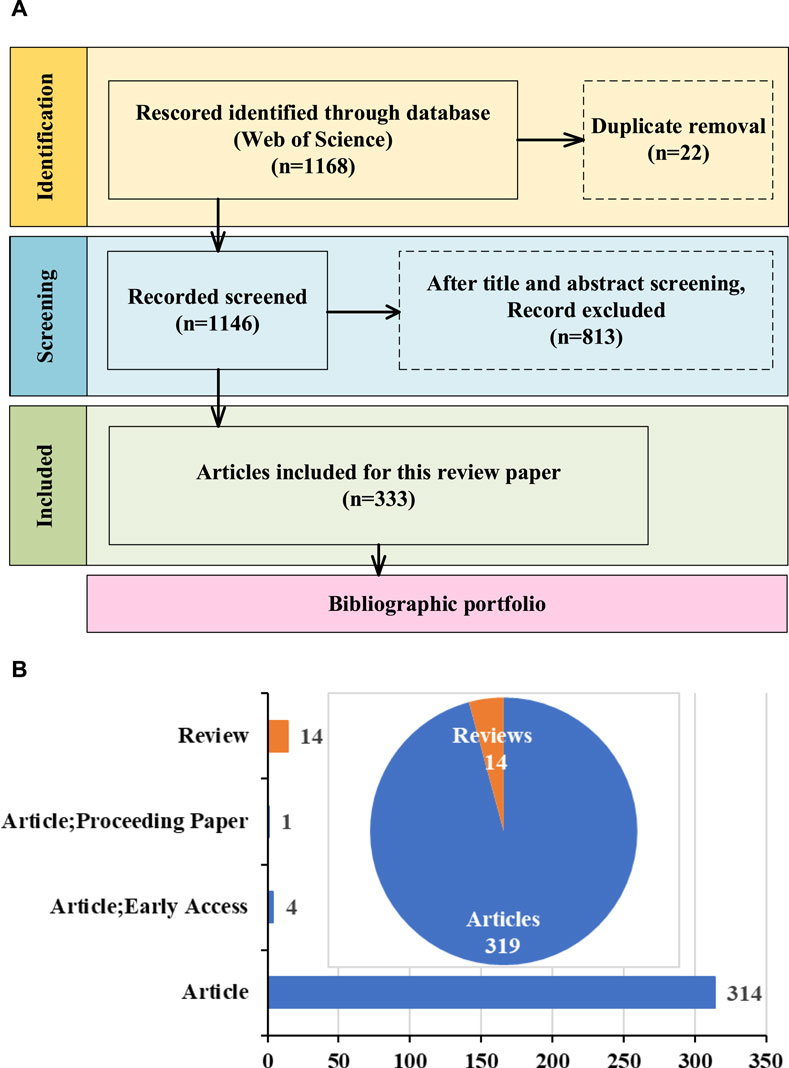
FIGURE 2. Bibliometric analysis. (A) Flowchart for screening retrieved articles. (B) Number and type of articles.
3.3 Bibliometric analysis combined with content analysis
This article will utilize CiteSpace 6.2.4 and employ both bibliometric analysis and content analysis methods to comprehensively illustrate the current research status and development trends of park green space equity from multiple perspectives. The specific structure of this paper is outlined as follows (see Figure 3). Firstly, in Section Four, a bibliometric analysis utilizing CiteSpace is employed to examine publication timelines, contributing countries, and high-frequency keywords, accompanied by brief explanations. Subsequently, Sections Five and Six adopt content analysis to systematically review selected literature in terms of research hotspots and influencing factors. Finally, Section Seven analyzes the limitations, prospects, and challenges of the study.
3.4 CiteSpace parameters
The bibliometric analysis of the dataset was conducted using CiteSpace 6.2.4. The “Full Record and Cited References” option was selected. Subsequently, the source data from the Web of Science (WOS) database was exported in “Plain text file” format and imported into CiteSpace. The parameter settings were configured as follows: ‘Time Slicing = From 2014, JAN To 2023, DEC' (The time range of the literature.), “Node Types = Country OR Keyword” (Selecting to conduct either country of publication analysis or keyword analysis.), “Pruning = Pathfinder AND Pruning sliced networks AND Pruning the merged network” (Trimming each slice and merging networks to highlight important network structures). All other parameters were kept at their default values.
4 Bibliometric review of equity in park green spaces
4.1 Bibliometric analysis
4.1.1 Annual publication trend
From 2014 to the present, based on the analysis of publication timelines (see Figure 4), the research can be categorized into the following two major phases:
• Exploratory Phase (2014–2018): This period, also referred to as the foundational research phase, witnessed a gradual fluctuation and growth in the annual publication volume of articles related to equity in park green space. Following a substantial period of applied research and foundational consolidation, the fundamental concepts and measurement methodologies of equity in park green space have essentially crystallized.
• Rapid Development Phase (2019-Present): The period from 2019 to 2023 (264 articles) represents nearly four times the number of articles from 2014 to 2018 (69 articles), there has been an exponential surge in publication volume, owing to the availability of refined network data from sources such as big data and internet mapping. Scholars have commenced endeavors to analyze the equity of parks and green spaces from the perspective of resident demand. Grounded in GIS analysis, this phase has evolved to encompass four major categories: container models, coverage models, gravity models, and two-step mobility search models (refer to Table 2). The significance of equity in park green space has progressively gained prominence.
4.1.2 Study countries
The node types were set to “country” (Node Types = country), and a temporal chart of publishing countries, delineated by the top 10 contributors, was generated (see Figure 5). In this network, N = 57 and E = 73, indicating scholarly contributions from 57 countries and regions globally with the formation of 73 collaborative relationships. In the publication country time zone graph, each country’s vertical alignment with the years represents the year of their first publication. The size of a country’s node corresponds to the total number of publications. Figure 5 reveals that several countries, including the United States, the United Kingdom, and Germany, initiated research in this field by publishing articles in 2014, followed by Chinese scholars in 2015. Notably, since 2017, Chinese scholars have exhibited a remarkable surge in publications (168), surpassing the United States and experiencing a substantial growth (see Figure 6). China’s total publication count is nearly three times that of the second-ranking United States (56) and more than five times that of the third-ranking Germany (30). However, as indicated by Table 3, China demonstrates lower centrality, signifying a deficit in international collaboration. Spain exhibits the highest centrality, maintaining close academic exchanges with nations worldwide, followed by Australia and the United States (The closer the collaboration between one country and others, the higher its centrality).
4.2 Analysis of research hotspots
4.2.1 Keyword co-occurrence analysis
The node types were designated as ‘keyword’ (Node Types = keyword), and a co-occurrence chart of high-frequency keywords (with a frequency of 15 or more) was generated (see Figure 7). The co-occurrence analysis graph primarily exists in the form of nodes and connecting lines. When keywords appear in the same papers, there is a connection between the two nodes. The size of a node indicates the frequency of occurrence of that keyword. The varying sizes of different-colored rings representing a specific keyword correspond to the volume of publications for different years, with the pink ring indicating high centrality of the keyword. The analysis of keyword co-occurrence serves to unveil research hotspots and frontiers within this domain. In addition to thematic terms, high-frequency keywords predominantly encompass the following categories:
• Health and Physical Activity: “health (89 occurrences),” “public health (27 occurrences),” “mental health (17 occurrences),” “healthcare (19 occurrences),” “physical activity (95 occurrences).”
• Ecological Environment: “ecosystem services (65 occurrences),” “environment (24 occurrences),” “exposure (15 occurrences).”
• Human Element: “people (16 occurrences).”
These findings indicate that, as research delves deeper, amidst the intensification of urbanization and environmental degradation, future studies are likely to witness an increase in research focused on the relationship between the ecological services of parks and green spaces and public health. Emphasis will particularly be placed on understanding the needs of different demographic groups.
4.2.2 Keyword clustering timeline analysis
Building upon the keyword co-occurrence analysis (Figure 8), Selecting ‘K' AND ‘LLR,’ we conducted clustering of literature keywords, using the log-likelihood ratio (LLR) algorithm to identify top-ranking terms as cluster labels. The keyword cluster timeline provides an analytical summary of the primary research directions in the development of equity in park green space over time (see Figure 8). In this representation, 15 lines correspond to 15 clusters, and the position of each circle denotes the year of the first appearance of the respective keyword. Arc-shaped connecting lines indicate instances where two keywords co-occurred in the same article. The weighted mean silhouette (S = 0.8794) and modularity (Q = 0.7237) obtained from the cluster analysis signify a significant clustering structure (If S value is greater than 0.5, then the clustering result is considered reasonable; Q value between 0.3 and 1 indicates that the group structure divided by the clustering analysis is significant, with higher values being better.), indicating rational results (Chaomei, 2005). As shown in Figure 8, the 15 axes represent 15 clusters, with the position of each circle indicating the year of the first appearance of the respective keyword. Arc-shaped connecting lines represent instances where these two keywords appeared in the same paper.
From Figure 8, it is evident that clusters such as #2 environmental equity, #3 environmental justice, #5 walking distance, and #13 green spaces have consistently been the research hotspots in the field of equity in park green space from 2014 to the present. Additionally, clusters like #0 mobile phone data, #1 geographically weighted regression, #4 variable catchment size, and #12 environmental gentrification, although starting later, have sustained ongoing research, indicating scholars’ enduring interest in exploring equity in park green space using various data and models, including the associated phenomenon of gentrification. The cluster #15 land surface temperature appeared later, has the shortest duration, and is still in the early stages of development, not yet forming symbiotic relationships with other clusters.
5 Research hotspots
Based on the focal points identified in the keyword co-occurrence analysis and keyword clustering timeline analysis summarized in Section 4.2, the research highlights in the field of park green space equity can be categorized into three main areas: analysis of park green space equity based on primary social fairness, analysis of park green space equity focusing on vulnerable groups, and the relationship between park green spaces and health.
5.1 Analysis of park green space equity based on primary social fairness
Based on the content analysis and extension in Section 2.2, it is evident that the analysis of park green space equity based on primary social fairness primarily focuses on the disparities in the ability and opportunity of different groups to access park green space services. The analytical approach is based on the multidimensional characteristics of park green spaces, such as quantity, quality, and type, as well as the demographic attributes of social groups within spatial units, to assess the ease of access to park green spaces for different social groups (whether different social groups can fairly enjoy access to park green spaces), thus determining equity.
The conclusions can be broadly categorized into two main types (see Table 4). The most common finding is the inequity of park green spaces, manifested in lower accessibility for the elderly, children, immigrants, and ethnic minority groups. Areas with higher housing prices tend to have higher accessibility to park green spaces, and park green space accessibility is higher in city centers compared to suburbs. However, very few studies fail to confirm the existence of park green space inequity. Some scholars attribute this to the different spatial scales used in research. Common research scales include streets, neighborhoods, and residential areas. Different spatial scales within the same city may yield different results, especially when the area of aggregation units far exceeds residents’ walking distances, which may lead to erroneous conclusions. Therefore, accessibility analysis should be conducted at finer scales whenever possible.
5.2 Analysis of park green space equity focusing on vulnerable groups
The focus of research on park green space equity has gradually shifted towards socially vulnerable groups such as low-income individuals, migrant workers, as well as physiologically vulnerable groups including children, the elderly, and women. Studies suggest that residents with lower socioeconomic status (SES) spend more time using parks and green spaces (Shen et al., 2017). Moreover, Black residents have access to more parks than White residents, but the per capita park area is lower for Black residents. This phenomenon is attributed to parks in predominantly Black communities being more crowded, especially in metropolitan areas (Julia et al., 2021). Faced with this inequality, if the government constructs a large number of parks and green spaces in areas lacking greenery, it can make surrounding residences more attractive, leading to an increase in housing prices, escalating living costs, and even displacement of original residents, ultimately resulting in gentrification (Boone et al., 2009). Noteworthy examples include the High Line park in the United States (Brisman, 2012) and the Cheonggyecheon Stream restoration project in South Korea (Lim et al., 2013). To address this issue, scholars propose the “Just green enough” strategy, advocating for the construction of small-scale, dispersed parks and green spaces rather than large expanses (Curran and Hamilton, 2012).
Chinese scholars, however, present two divergent views on this matter. One perspective suggests that vulnerable groups are gradually moving away from parks and green spaces. For instance, research indicates that park accessibility is negatively correlated with building age and positively correlated with housing prices (Yu et al., 2020). Community parks built in earlier years exhibit higher accessibility, but in recent housing development, the elderly are increasingly distancing themselves from parks and green spaces. The other perspective contends that compared to ordinary residents, vulnerable groups such as immigrants, the unemployed, and residents of welfare housing are more likely to live in areas with better park usage rights (Nesbitt et al., 2019). Two main reasons account for this: first, it is related to the urban green space planning strategy of Shanghai, which emphasizes even distribution of public green space; second, vulnerable groups reside in high-rise buildings in the city center, and although they have better park green space accessibility, their living conditions are extremely poor due to poor economic conditions. Concurrently, with the increasingly severe aging population in China, the elderly face a serious shortage of park green space usage. Studies reveal that different modes of transportation and varying park green space sizes can influence the degree of fairness in elderly people’s access to these spaces (Meng et al., 2020). Addressing this issue, some scholars advocate for greater government leadership in planning, giving priority to the interests of vulnerable groups (Hewko et al., 2002).
5.3 The relationship between park green space and health
The research is primarily categorized into two main areas: the relationship between park green space accessibility and health, and the relationship between park green space ecological services and health.
According to Table 5, research on the relationship between park green space accessibility and health in China mainly focuses on large cities such as Beijing and ice and snow cities such as Harbin, as well as in Western countries like the United States, the United Kingdom, and Canada. Health data is primarily obtained through questionnaire surveys, face-to-face interviews, and publicly available databases. Some scholars have studied the relationship between park green space equity and resident health from the perspectives of accessibility, distance, and coverage. The majority of research findings indicate a positive effect of park green space equity on residents’ psychological and physiological health (Wolch et al., 2014; Dadvand et al., 2016; Rigolon, 2016). Park green space accessibility is negatively correlated with the incidence of various diseases among residents (Kaczynski and Henderson, 2007), particularly cardiovascular and cerebrovascular diseases (Haiya, 2011). However, individual studies suggest no correlation between park green space accessibility, proportion, supply-demand ratio, and health.
The relationship between park green space ecological services and health has been explored by scholars. Some researchers (Zhang et al., 2021c) have conducted a review and summary of international research findings, outlining the promotion benefits of green spaces on health, factors influencing the effectiveness of health impacts, and mechanisms by which green spaces promote health. Others have delved into the physiological, psychological, and social correlations between green spaces and human health, proposing the concept of green medicine and discussing auxiliary approaches to maintaining the physical and mental health of urban residents (Kaczynski et al., 2008).
6 Analysis of factors influencing equity in park green spaces
The factors influencing equity in park green spaces are both significant and complex, primarily involving regional economy and government planning, as well as residents’ economic capacity.
6.1 Regional economy and government planning
The influence of regional economy on the equity of park green spaces is primarily manifested in the level of supply. In China, as a vast country with uneven development, significant disparities exist between urban and rural areas, as well as between eastern and western regions, and between the north and south. In economically developed areas, local governments often possess more financial resources, enabling them to provide more park green space resources, thereby ensuring relatively sufficient supply in these areas (Li et al., 2018). For instance, the central and southeastern coastal regions typically maintain higher levels of park green space coverage. However, in areas with harsh geographical conditions or relatively underdeveloped economies, such as mountainous or desert regions, constraints on park green space construction are considerable, resulting in inadequate supply, and in some cases, levels even below the national average (Chen and Wang, 2013; Zhao et al., 2013). Conversely, in Western countries like the United States, park green space construction is typically funded through mechanisms such as property taxes. Nevertheless, due to limited local funds, there is often a need to seek financial support from non-profit organizations, institutions, and federal governments at the national and state levels (Harnik and Barnhart, 2015). This competitive allocation of funds may exacerbate inequalities (Joassart-Marcelli et al., 2011), with affluent areas receiving more support, further aggravating disparities in park green space distribution.
Government planning plays a crucial role in the spatial layout and construction of park green spaces. Unlike Western countries, where park green spaces are typically planned and constructed by the government and open to the public free of charge, in China, traditional planning tends to rely on metrics like per capita park area to gauge the level of supply. Consequently, park green spaces are often densely concentrated in areas with high population density, while areas with lower population density experience shortages (Liyan et al., 2023). Furthermore, some local governments, in pursuit of political achievements and prestige, may excessively prioritize increasing park green space coverage, investing heavily in superficial projects, thereby neglecting the actual needs and usage patterns of park green spaces (Zhao et al., 2013). This detachment between park green space planning and residents’ demands exacerbates the disparities between planning intentions and community needs (Chen et al., 2017).
6.2 The economic capacity of residents
In China, park green spaces are often closely linked to high-quality housing, with high-quality parks typically adjacent to upscale residences, while lower-quality parks are connected to relatively lower-end housing. Higher-income groups usually have the ability to purchase premium housing, thus enjoying access to better-quality park green spaces. Conversely, lower-income groups may only reside in environments with poorer-quality housing, leading to disparities in park green space utilization among residents of different socioeconomic statuses, further exacerbating spatial inequalities in park green space distribution (Chen et al., 2020; Wu and Rowe, 2022). Studies in Western countries have also confirmed this observation, showing that in capitalist societies, higher socioeconomic status (SES) groups typically have access to larger and higher-quality park green spaces, while lower SES groups often lack equivalent opportunities (Zhu and Zhang, 2008; Alessandro and Jeremy, 2018; 2020; Browning et al., 2022).
Racial discrimination and segregation are also significant factors contributing to the inequitable distribution of park green spaces (Wolch et al., 2014; Rigolon, 2016). Historically, due to the dominant position of white people, public facilities such as parks were predominantly located in affluent areas, while industrial zones and high-density housing were situated in areas inhabited by people of color and low-income individuals, a legacy that continues to have profound effects. Racial discrimination and segregation make it more difficult for communities of color to access park green spaces (Dai, 2011), even when they reside closer to them. Issues such as smaller park areas, poor quality, and environmental pollution discourage residents from utilizing these spaces (Alessandro and Jeremy, 2018), exacerbating the inequities in park green space distribution (Wolch et al., 2013).
7 Prospects and challenges
7.1 Opportunities for future research
(1) Equity of Parks and Green Spaces for Different User Groups: Future research should focus on the fairness of park green space usage among different demographic groups, especially vulnerable populations such as the elderly (Guo et al., 2019), children, and low-income individuals.
(2) Emerging Evaluation Methods and Data: Future studies can further integrate the latest information technologies, such as mobile signaling data (Xiao et al., 2019; Heikinheimo et al., 2020), big data, Public Participation Geographic Information Systems (PPGIS) (Brown et al., 2014), and the latest fairness evaluation criteria, such as the 3–30-300 rule (Browning et al., 2024), to accurately simulate the diverse and complex transportation patterns and travel habits of urban residents. This approach will enable precise identification of the needs and behaviors of different population groups.
(3) Park green space equity based on perceived accessibility: Perceived accessibility refers to residents’ subjective perceptions and evaluations of the accessibility of park green spaces, emphasizing their perception and satisfaction with the level of accessibility (Sugiyama et al., 2008; Mass et al., 2009). Studies have shown that actual spatial accessibility does not completely match perceived accessibility (Wang et al., 2015; Crouse et al., 2017; Xie et al., 2018; Huang and Lin, 2023), especially in areas with low perceived accessibility within cities (Crouse et al., 2017). This difference is mainly attributed to factors such as residents’ familiarity with the objective environment, the completeness of accessibility measurement methods, and individual differences among residents. Some scholars have studied perceived accessibility by comparing the time or distance required to reach destinations. For example, some studies have compared perceived distances to actual distances for several different destinations and found that destinations closer to home are often overestimated, meaning that the perceived distance is greater than the actual distance (Wang et al., 2015). In the future, it is important to focus on the subjective perceptions of different groups and further refine research on park green space equity.
(4) Equity in park green space and Surface Temperature: In recent years, many regions globally have faced extreme high-temperature weather. Numerous studies have confirmed that parks and green spaces can effectively alleviate the urban heat island effect. Therefore, providing sufficient and equitable access to parks for residents is considered crucial for sustainable urban development. Scholars have already conducted relevant studies, such as in Dongguan, China, to explore whether the spatially equitable distribution of parks and green spaces contributes to mitigating the urban heat island effect and improving the urban thermal environment (Chao et al., 2022). Other researchers have assessed the carbon reduction potential of 65 urban parks based on the cumulative outdoor carbon reduction model of park surface temperature reduction curves, conducting a network analysis of the spatial accessibility of cooling zones in Da Xi Park (Du et al., 2023). Air temperature might be more salient, even if harder to implement. Future research should delve deeper into the specific relationship between parks and green spaces and surface temperature. For instance, investigating the scale of parks required within certain land areas to effectively reduce surface temperature, and exploring the intricate connection between the equitable distribution of parks and green spaces and surface temperature.
7.2 Limitations of the study
• This study has limitations regarding the selection of databases: The literature was derived from the WOS core database. The choice of databases may result in the omission of some relevant literature, posing a risk of literature gaps. Future research could consider expanding the scope of database selection, such as incorporating Scopus, PubMed, and others, to obtain a more comprehensive literature review.
• Due to the large sample size of the literature, specific quantitative analysis of the research results was not feasible. Subsequent studies may consider increasing the criteria for selecting literature to reduce the research sample, thereby making the analysis results more persuasive.
These limitations should be addressed and rectified in subsequent research to enhance the comprehensiveness and objectivity of the study. Additionally, a more detailed content analysis of relevant literature is warranted to gain a deeper understanding of the current status and trends in the field of equity in park green space.
8 Conclusion
To unveil the research focal points, developmental trends, and influencing mechanisms in the domain of equity in park green space, this study employed CiteSpace software to analyze research spanning from 2014 to December 2023. The key findings are summarized as follows:
(1) The investigation into equity in park green space has gained increasing prominence, delineated into two major phases: a gradual exploration phase (2014–2018) and a rapid development phase (2018 to the present). The primary nations engaged in this research arena include China, the United States, and Germany. Notably, China’s cumulative publication output is nearly three times that of the second-ranked United States (56) and over five times that of the third-ranked Germany (30). However, collaborative efforts with other nations remain limited.
(2) The current research in this field mainly focuses on three key areas: analysis of park green space equity based on primary social fairness, analysis of park green space equity focusing on vulnerable groups, and the relationship between park green spaces and health.
(3) The influencing factors of park green space equity mainly involve two major aspects: regional economy and government planning, and residents’ economic capability and racial discrimination.
(4) In the future, research can be directed towards several areas including park green space equity among different groups, emerging evaluation methods and data, park green space equity based on perceived accessibility, and the relationship between park green space equity and surface temperature.
In conclusion, this study presents novel insights and recommendations for advancing research on equity in park green space. The outcomes offer valuable references for global park green space planning and management, contributing theoretical support for the further development of equity-focused research in this domain.
Author contributions
LY: Funding acquisition, Methodology, Project administration, Writing–review and editing, Funding acquisition, Methodology, Project administration, Writing–review and editing. XJ: Data curation, Software, Writing–original draft, Data curation, Software, Writing–original draft. JZ: Writing–review and editing.
Funding
The author(s) declare that financial support was received for the research, authorship, and/or publication of this article. This research was funded by Zhejiang Provincial Department of Education, grant number Y202146282.
Conflict of interest
The authors declare that the research was conducted in the absence of any commercial or financial relationships that could be construed as a potential conflict of interest.
Publisher’s note
All claims expressed in this article are solely those of the authors and do not necessarily represent those of their affiliated organizations, or those of the publisher, the editors and the reviewers. Any product that may be evaluated in this article, or claim that may be made by its manufacturer, is not guaranteed or endorsed by the publisher.
References
Adhikari, B., Delgado-Ron, J. A., Van Den Bosch, M., Dummer, T., Hong, A., Sandhu, J., et al. (2021). Community design and hypertension: walkability and park access relationships with cardiovascular health. Int. J. Hyg. Environ. Health 237, 113820. doi:10.1016/j.ijheh.2021.113820
Alessandro, R., and Jeremy, N. (2018). What shapes uneven access to urban amenities? Thick injustice and the legacy of racial discrimination in denver’s parks. J. Plan. Educ. Res. 41 (3), 0739456X1878925. doi:10.1177/0739456X18789251
Alessandro, R., and Jeremy, N. (2020). Green gentrification or ‘just green enough’: do park location, size and function affect whether a place gentrifies or not? Urban Stud. 57 (2), 402–420. doi:10.1177/0042098019849380
Ayala-Azcárraga, C., Diaz, D., and Zambrano, L. (2019). Characteristics of urban parks and their relation to user well-being. Landsc. Urban Plan. 189, 27–35. doi:10.1016/j.landurbplan.2019.04.005
Bao, Z., Bai, Y., and Geng, T. (2023). Examining spatial inequalities in public green space accessibility: a focus on disadvantaged groups in england.
Boone, C. G., Buckley, G. L., Grove, J. M., and Sister, C. (2009). Parks and people: an environmental justice inquiry in Baltimore, Maryland. Ann. Assoc. Am. Geogr. 99 (4), 767–787. doi:10.1080/00045600903102949
Brisman, A. (2012). An elevated challenge to ‘broken windows’: the High Line (New York). Crime, Media, Cult. Int. J. 8 (3), 381. doi:10.1177/1741659012443235
Brown, G., Schebella, M. F., and Weber, D. (2014). Using participatory GIS to measure physical activity and urban park benefits. Landsc. Urban Plan. 121, 34–44. doi:10.1016/j.landurbplan.2013.09.006
Browning, M. H. E. M., Locke, D. H., Konijnendijk, C., Labib, S. M., Rigolon, A., Yeager, R., et al. (2024). Measuring the 3-30-300 rule to help cities meet nature access thresholds. Sci. Total Environ. 907, 167739. doi:10.1016/j.scitotenv.2023.167739
Browning, M. H. E. M., Rigolon, A., Ogletree, S., Wang, R., Klompmaker, J. O., Bailey, C., et al. (2022). The PAD-US-AR dataset: measuring accessible and recreational parks in the contiguous United States. Sci. Data 9 (1), 773. doi:10.1038/s41597-022-01857-7
Chang, Z., Chen, J., Li, W., and Li, X. (2019). Public transportation and the spatial inequality of urban park accessibility: new evidence from Hong Kong. Transp. Res. Part D Transp. Environ. 76, 111–122. doi:10.1016/j.trd.2019.09.012
Chao, X., Guangdong, C., Qianyuan, H., Meirong, S., Qiangqiang, R., Wencong, Y., et al. (2022). Can improving the spatial equity of urban green space mitigate the effect of urban heat islands? An empirical study. Sci. total Environ. 841, 156687. doi:10.1016/j.scitotenv.2022.156687
Chaomei, C. (2005). CiteSpace II: detecting and visualizing emerging trends and transient patterns in scientific literature. J. Am. Soc. Inf. Sci. Technol. 57 (3), 359–377. doi:10.1002/asi.20317
Chen, B., Nie, Z., Chen, Z., and Xu, B. (2017). Quantitative estimation of 21st-century urban greenspace changes in Chinese populous cities. Sci. Total Environ. 609, 956–965. doi:10.1016/j.scitotenv.2017.07.238
Chen, C. (2017). Science mapping: a systematic review of the literature. J. Data Inf. Sci. 2, 1–40. doi:10.1515/jdis-2017-0006
Chen, W. Y., and Wang, D. T. (2013). Urban forest development in China: natural endowment or socioeconomic product? Cities 35, 62–68. doi:10.1016/j.cities.2013.06.011
Chen, Y., Yue, W., and La Rosa, D. (2020). Which communities have better accessibility to green space? An investigation into environmental inequality using big data. Landsc. Urban Plan. 204, 103919. doi:10.1016/j.landurbplan.2020.103919
Cho, C. M. (2004). Study on effects of resident-perceived neighborhood boundaries on public services accessibility & its relation to utilization: using Geographic Information System, focusing on the case of public parks in Austin, Texas.
Coppel, G., and Wüstemann, H. (2017). The impact of urban green space on health in Berlin, Germany: empirical findings and implications for urban planning. Landsc. Urban Plan. 167, 410–418. doi:10.1016/j.landurbplan.2017.06.015
Crouse, D. L., Pinault, L., Balram, A., Hystad, P., Peters, P. A., Chen, H., et al. (2017). Urban greenness and mortality in Canada's largest cities: a national cohort study. Lancet Planet. Health 1 (7), e289–e297. doi:10.1016/s2542-5196(17)30118-3
Curran, W., and Hamilton, T. (2012). Just green enough: contesting environmental gentrification in Greenpoint, Brooklyn. Local Environ. 17 (9), 1027–1042. doi:10.1080/13549839.2012.729569
Dadvand, P., Bartoll, X., Basagaña, X., Dalmau-Bueno, A., Martinez, D., Ambros, A., et al. (2016). Green spaces and General Health: roles of mental health status, social support, and physical activity. Environ. Int. 91, 161–167. doi:10.1016/j.envint.2016.02.029
Dai, D. (2011). Racial/ethnic and socioeconomic disparities in urban green space accessibility: where to intervene? Landsc. Urban Plan. 102 (4), 234–244. doi:10.1016/j.landurbplan.2011.05.002
Donovan, G. H., and Butry, D. T. (2009). The value of shade: estimating the effect of urban trees on summertime electricity use. Energy Build. 41 (6), 662–668. doi:10.1016/j.enbuild.2009.01.002
Du, C., Jia, W., and Wang, K. (2023). Valuing carbon saving potential of urban parks in thermal mitigation: linking accumulative and accessibility perspectives. Urban Clim. 51, 101645. doi:10.1016/j.uclim.2023.101645
Fang, L., Zhang, D., Liu, T., Yao, S., Fan, Z., Xie, Y., et al. (2021). A multi-level investigation of environmental justice on cultural ecosystem services at a national scale based on social media data: a case of accessibility to Five-A ecological attractions in China. J. Clean. Prod. 286, 124923. doi:10.1016/j.jclepro.2020.124923
Fian, L., White, M. P., Thaler, T., Arnberger, A., Elliott, L. R., and Friesenecker, M. (2023). Inequalities in residential nature and nature-based recreation are not universal: a country-level analysis in Austria. Urban For. Urban Green. 85, 127977. doi:10.1016/j.ufug.2023.127977
Guo, S., Song, C., Pei, T., Liu, Y., Ma, T., Du, Y., et al. (2019). Accessibility to urban parks for elderly residents: perspectives from mobile phone data. Landsc. Urban Plan. 191, 103642. doi:10.1016/j.landurbplan.2019.103642
Haiya, J. (2011). Advance in the equity of spatial distribution of urban public service in western countries.
Handley, J., Slinn, P., Barber, A., Baker, M., Jones, C., and Lindley, S. (2003). Accessible natural green space standards in towns and cities: a review and toolkit for their implementation.
Harnik, P., and Barnhart, K. (2015). Parks as community development: when it comes to gritty cities, conserving pristine land is not the only way to create places. Editor D. T. T Washington.
Heikinheimo, V., Tenkanen, H., Bergroth, C., Järv, O., Hiippala, T., and Toivonen, T. (2020). Understanding the use of urban green spaces from user-generated geographic information. Landsc. Urban Plan. 201, 103845. doi:10.1016/j.landurbplan.2020.103845
Hewko, J., Smoyer-Tomic, K. E., and Hodgson, M. J. (2002). Measuring neighbourhood spatial accessibility to urban amenities: does aggregation error matter? Environ. Plan. A 34 (7), 1185–1206. doi:10.1068/a34171
Hou, Y., Chen, X., Liu, Y., and Xu, D. (2023). Association between UGS patterns and residents' health status: a report on residents' health in China's old industrial areas. Environ. Res. 239, 117199. doi:10.1016/j.envres.2023.117199
Houlden, V., Weich, S., and Jarvis, S. (2017). A cross-sectional analysis of green space prevalence and mental wellbeing in England. BMC Public Health 17 (1), 460. doi:10.1186/s12889-017-4401-x
Huang, W., and Lin, G. (2023). The relationship between urban green space and social health of individuals: a scoping review. Urban For. Urban Green. 85, 127969. doi:10.1016/j.ufug.2023.127969
Iraegui, E., Augusto, G., and Cabral, P. (2020). Assessing equity in the accessibility to urban green spaces according to different functional levels.
Joassart-Marcelli, P., Wolch, J., and Salim, Z. (2011). Building the healthy city: the role of nonprofits in creating active urban parks. Urban Geogr. 32 (5), 682–711. doi:10.2747/0272-3638.32.5.682
Julia, R., Christiane, B., Julia, W., and André, C. (2021). Socioeconomic differences in walking time of children and adolescents to public green spaces in urban areas—results of the German environmental survey (2014–2017). Int. J. Environ. Res. public health 18 (5), 2326. doi:10.3390/ijerph18052326
Kabisch, N., and Haase, D. (2014). Green justice or just green? Provision of urban green spaces in Berlin, Germany. Landsc. Urban Plan. 122, 129–139. doi:10.1016/j.landurbplan.2013.11.016
Kaczynski, A. T., and Henderson, K. A. (2007). Environmental correlates of physical activity: a review of evidence about parks and recreation. Leis. Sci. 29 (4), 315–354. doi:10.1080/01490400701394865
Kaczynski, A. T., Potwarka, L. R., and Saelens, B. E. (2008). Association of park size, distance, and features with physical activity in neighborhood parks. Am. J. public health 98 (8), 1451–1456. doi:10.2105/ajph.2007.129064
Kim, Y., Corley, E. A., Won, Y., and Kim, J. (2023). Green space access and visitation disparities in the phoenix metropolitan area. Landsc. Urban Plan. 237, 104805. doi:10.1016/j.landurbplan.2023.104805
Kroeger, T., Escobedo, F. J., Hernandez, J. L., Varela, S., Delphin, S., Fisher, J. R. B., et al. (2014). Reforestation as a novel abatement and compliance measure for ground-level ozone. Proc. Natl. Acad. Sci. 111 (40), E4204–E4213. doi:10.1073/pnas.1409785111
Leng, H., Li, S., Yan, S., and An, X. (2020). Exploring the relationship between green space in a neighbourhood and cardiovascular health in the winter city of China: a study using a health survey for Harbin.
Li, F., Wang, X., Liu, H., Li, X., Zhang, X., Sun, Y., et al. (2018). Does economic development improve urban greening? Evidence from 289 cities in China using spatial regression models. Environ. Monit. Assess. 190 (9), 541. doi:10.1007/s10661-018-6871-4
Li, H., Ta, N., Yu, B., and Wu, J. (2023). Are the accessibility and facility environment of parks associated with mental health? A comparative analysis based on residential areas and workplaces. Landsc. Urban Plan. 237, 104807. doi:10.1016/j.landurbplan.2023.104807
Lim, H., Kim, J., Potter, C., and Bae, W. (2013). Urban regeneration and gentrification: land use impacts of the Cheonggye Stream Restoration Project on the Seoul's central business district. Habitat Int. 39, 192–200. doi:10.1016/j.habitatint.2012.12.004
Lin, D., Sun, Y., Yang, Y., Han, Y., and Xu, C. (2023). Urban park use and self-reported physical, mental, and social health during the COVID-19 pandemic: an on-site survey in Beijing, China. Urban For. Urban Green. 79, 127804. doi:10.1016/j.ufug.2022.127804
Liotta, C., Kervinio, Y., Levrel, H., and Tardieu, L. (2020). Planning for environmental justice - reducing well-being inequalities through urban greening. Environ. Sci. Policy 112, 47–60. doi:10.1016/j.envsci.2020.03.017
Liu, D., Kwan, M.-P., and Kan, Z. (2021). Analysis of urban green space accessibility and distribution inequity in the City of Chicago. Urban For. Urban Green. 59, 127029. doi:10.1016/j.ufug.2021.127029
Liyan, X., Yin, H., and Fang, J. (2023). Evaluating the supply-demand relationship for urban green parks in Beijing from an ecosystem service flow perspective. Urban For. Urban Green. 85, 127974. doi:10.1016/j.ufug.2023.127974
Lucy, W. (1981). Equity and planning for local services. J. Am. Plan. Assoc. 47 (4), 447–457. doi:10.1080/01944368108976526
Maas, H., Verheij, R. A., de Vries, S., Spreeuwenberg, P., Schellevis, F. G., and Groenewegen, P. P. (2009). Morbidity is related to a green living environment. J. Epidemiol. community health 63 (12), 967–973. doi:10.1136/jech.2008.079038
Meng, G., Bingxi, L., Yu, T., and Dawei, X. (2020). Equity to urban parks for elderly residents: perspectives of balance between supply and demand. Int. J. Environ. Res. public health 17 (22), 8506. doi:10.3390/ijerph17228506
Nesbitt, L., Meitner, M. J., Girling, C., Sheppard, S. R. J., and Lu, Y. (2019). Who has access to urban vegetation? A spatial analysis of distributional green equity in 10 US cities. Landsc. Urban Plan. 181, 51–79. doi:10.1016/j.landurbplan.2018.08.007
Noordzij, J. M., Marielle, A. B., Joost Oude, G., and Frank, J. V. L. (2020). Effect of changes in green spaces on mental health in older adults: a fixed effects analysis. J. Epidemiol. community health 74 (1), 48–56. doi:10.1136/jech-2019-212704
Pope, D., Tisdall, R., Middleton, J., Verma, A., Van Ameijden, E., Birt, C., et al. (2018). Quality of and access to green space in relation to psychological distress: results from a population-based cross-sectional study as part of the EURO-URHIS 2 project. Eur. J. Public Health 28 (1), 39–38. doi:10.1093/eurpub/ckx217
Rahimi, A., Davatgar Khorsand, E., Breuste, J., and Karimzadeh, H. (2023). Gender justice in green space use in relation to different socio-economic conditions in Tabriz, Iran. Sustain. Cities Soc. 99, 104973. doi:10.1016/j.scs.2023.104973
Rao, Y., Zhong, Y., He, Q., and Dai, J. (2022). Assessing the equity of accessibility to urban green space: a study of 254 cities in China.
Rigolon, A. (2016). A complex landscape of inequity in access to urban parks: a literature review. Landsc. Urban Plan. 153, 160–169. doi:10.1016/j.landurbplan.2016.05.017
Shen, Y., Sun, F., and Che, Y. (2017). Public green spaces and human wellbeing: mapping the spatial inequity and mismatching status of public green space in the Central City of Shanghai. Urban For. Urban Green. 27, 59–68. doi:10.1016/j.ufug.2017.06.018
Standard for Classification of Urban Green Space (2017). Standard for classification of urban green space. Beijing, China: China Architecture & Building Press.
Sugiyama, A., Leslie, E., Giles-Corti, B., and Owen, N. (2008). Associations of neighbourhood greenness with physical and mental health: do walking, social coherence and local social interaction explain the relationships? J. Epidemiol. community health 62 (5), e9. doi:10.1136/jech.2007.064287
Tamosiunas, A., Grazuleviciene, R., Luksiene, D., Dedele, A., Reklaitiene, R., Baceviciene, M., et al. (2014). Accessibility and use of urban green spaces, and cardiovascular health: findings from a Kaunas cohort study. Environ. Health 13 (1), 20. doi:10.1186/1476-069x-13-20
Tian, M., Yuan, L., Guo, R., Wu, Y., and Liu, X. (2021). Sustainable development: investigating the correlations between park equality and mortality by multilevel model in Shenzhen, China. Sustain. Cities Soc. 75, 103385. doi:10.1016/j.scs.2021.103385
Wang, D., Brown, G., Zhong, G., Liu, Y., and Mateo-Babiano, I. (2015). Factors influencing perceived access to urban parks: a comparative study of Brisbane (Australia) and Zhongshan (China). Habitat Int. 50, 335–346. doi:10.1016/j.habitatint.2015.08.032
Wicks, B. E., and Crompton, J. L. (1986). Citizen and administrator perspectives of equity in the delivery of park services. Leis. Sci. 8 (4), 341–365. doi:10.1080/01490408609513080
Wolch, J., Wilson, J. P., and Fehrenbach, J. (2013). Parks and park funding in Los Angeles: an equity-mapping analysis. Urban Geogr. 26 (1), 4–35. doi:10.2747/0272-3638.26.1.4
Wolch, J. R., Byrne, J., and Newell, J. P. (2014). Urban green space, public health, and environmental justice: the challenge of making cities ‘just green enough. Landsc. Urban Plan. 125, 234–244. doi:10.1016/j.landurbplan.2014.01.017
Wu, L., and Kim, S. K. (2021). Health outcomes of urban green space in China: evidence from Beijing. Sustain. Cities Soc. 65, 102604. doi:10.1016/j.scs.2020.102604
Wu, L., and Rowe, P. G. (2022). Green space progress or paradox: identifying green space associated gentrification in Beijing. Landsc. Urban Plan. 219, 104321. doi:10.1016/j.landurbplan.2021.104321
Xiao, Y., Wang, D., and Fang, J. (2019). Exploring the disparities in park access through mobile phone data: evidence from Shanghai, China. Landsc. Urban Plan. 181, 80–91. doi:10.1016/j.landurbplan.2018.09.013
Xie, B., An, Z., Zheng, Y., and Li, Z. (2018). Healthy aging with parks: association between park accessibility and the health status of older adults in urban China. Sustain. Cities Soc. 43, 476–486. doi:10.1016/j.scs.2018.09.010
Yang, H., Chen, T., Zeng, Z., and Mi, F. (2022). Does urban green space justly improve public health and well-being? A case study of Tianjin, a megacity in China. J. Clean. Prod. 380, 134920. doi:10.1016/j.jclepro.2022.134920
Yang, H., Wen, J., Lu, Y., and Peng, Q. (2023). A quasi-experimental study on the impact of park accessibility on the mental health of undergraduate students. Urban For. Urban Green. 86, 127979. doi:10.1016/j.ufug.2023.127979
Yu, S., Zhu, X., and He, Q. (2020). An assessment of urban park access using house-level data in urban China: through the lens of social equity. Int. J. Environ. Res. public health 17 (7), 2349. doi:10.3390/ijerph17072349
Zhan, D., Zhang, Q., Kwan, M.-P., Liu, J., Zhan, B., and Zhang, W. (2022). Impact of urban green space on self-rated health: evidence from Beijing. Front. Public Health 10, 999970. doi:10.3389/fpubh.2022.999970
Zhang, J. (2023). Inequalities in the quality and proximity of green space exposure are more pronounced than in quantity aspect: evidence from a rapidly urbanizing Chinese city. Urban For. Urban Green. 79, 127811. doi:10.1016/j.ufug.2022.127811
Zhang, J., Cheng, Y., and Zhao, B. (2021a). Assessing the inequities in access to peri-urban parks at the regional level: a case study in Chinas largest urban agglomeration. Urban For. Urban Green. 65, 127334. doi:10.1016/j.ufug.2021.127334
Zhang, J., Cheng, Y., and Zhao, B. (2021b). How to accurately identify the underserved areas of peri-urban parks? An integrated accessibility indicator. Ecol. Indic. 122, 107263. doi:10.1016/j.ecolind.2020.107263
Zhang, J., Feng, X., Shi, W., Cui, J., Peng, J., Lei, L., et al. (2021c). Health promoting green infrastructure associated with green space visitation. Urban For. Urban Green. 64, 127237. doi:10.1016/j.ufug.2021.127237
Zhang, J., Yu, Z., Cheng, Y., Chen, C., Wan, Y., Zhao, B., et al. (2020). Evaluating the disparities in urban green space provision in communities with diverse built environments: the case of a rapidly urbanizing Chinese city. Build. Environ. 183, 107170. doi:10.1016/j.buildenv.2020.107170
Zhang, L., Chen, P., and Hui, F. (2022a). Refining the accessibility evaluation of urban green spaces with multiple sources of mobility data: a case study in Shenzhen, China. Urban For. Urban Green. 70, 127550. doi:10.1016/j.ufug.2022.127550
Zhang, S., Yu, P., Chen, Y., Jing, Y., and Zeng, F. (2022b). Accessibility of park green space in wuhan, China: implications for spatial equity in the post-COVID-19 era. Int. J. Environ. Res. Public Health 19, 5440. doi:10.3390/ijerph19095440
Zhang, Y., Van Dijk, T., Tang, J., and Berg, A. E. V. D. (2015). Green space attachment and health: a comparative study in two urban neighborhoods. Int. J. Environ. Res. public health 12 (11), 14342–14363. doi:10.3390/ijerph121114342
Zhao, J., Chen, S., Jiang, B., Ren, Y., Wang, H., Vause, J., et al. (2013). Temporal trend of green space coverage in China and its relationship with urbanization over the last two decades. Sci. Total Environ. 442, 455–465. doi:10.1016/j.scitotenv.2012.10.014
Keywords: park green space, equity, citespace, China, review
Citation: Yan L, Jin X and Zhang J (2024) Equity in park green spaces: a bibliometric analysis and systematic literature review from 2014-2023. Front. Environ. Sci. 12:1374973. doi: 10.3389/fenvs.2024.1374973
Received: 23 January 2024; Accepted: 07 March 2024;
Published: 19 March 2024.
Edited by:
Stefano Salata, Polytechnic of Milan, ItalyReviewed by:
Kangjae Lee, Kyungpook National University, Republic of KoreaRosilawati Zainol, Universiti Malaya, Malaysia
Dexter Henry Locke, Forest Service (USDA), United States
Copyright © 2024 Yan, Jin and Zhang. This is an open-access article distributed under the terms of the Creative Commons Attribution License (CC BY). The use, distribution or reproduction in other forums is permitted, provided the original author(s) and the copyright owner(s) are credited and that the original publication in this journal is cited, in accordance with accepted academic practice. No use, distribution or reproduction is permitted which does not comply with these terms.
*Correspondence: Lijie Yan, eWFubGlqaWVAc2l0LmVkdS5jbg==
 Lijie Yan
Lijie Yan Xiaoying Jin
Xiaoying Jin Jinquan Zhang2
Jinquan Zhang2